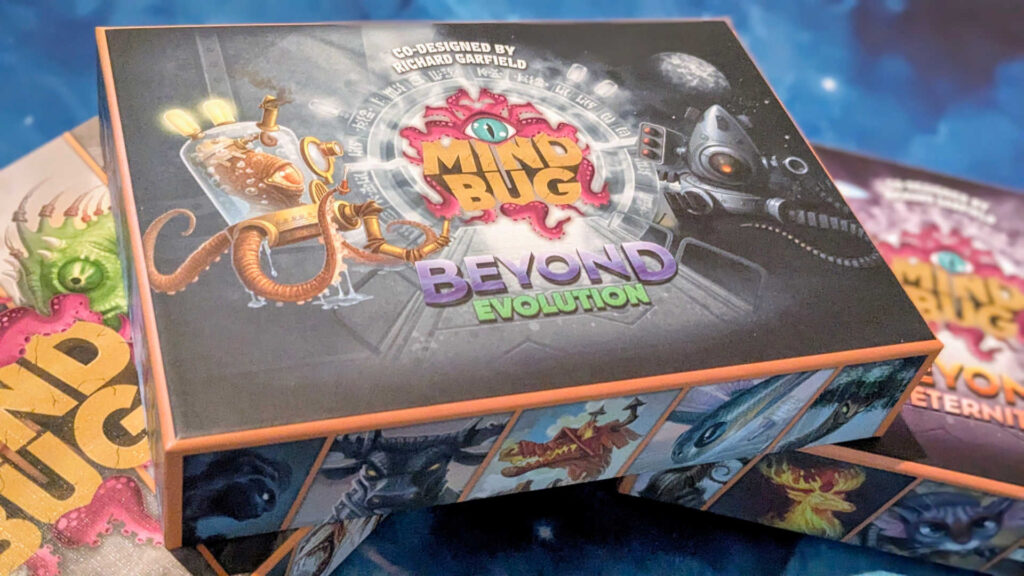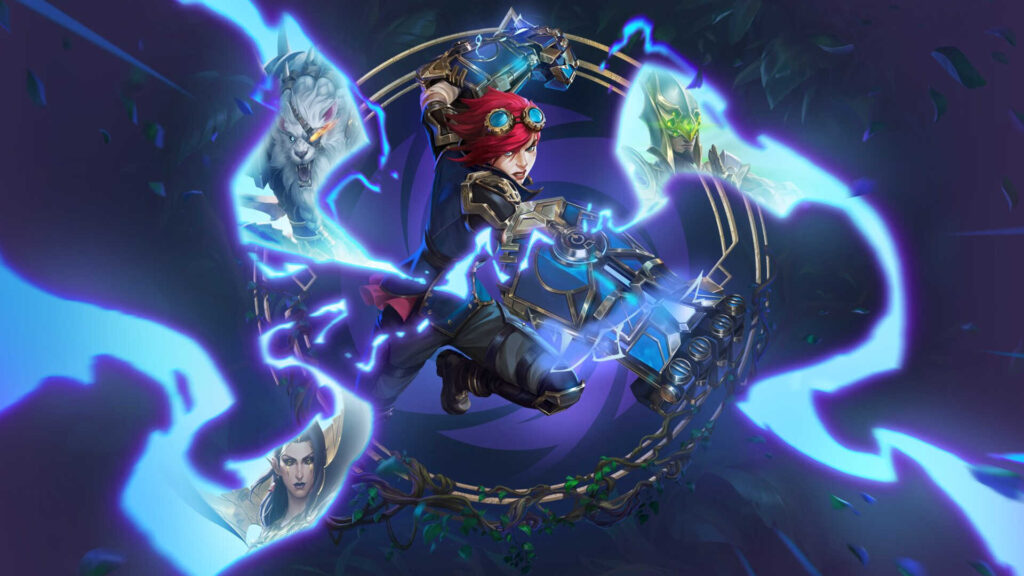If you’ve already read our review of standalone card game, Mindbug (also known as Mindbug: First Contact), you’ll know that it’s a game we rated very highly indeed, and has rapidly become one of our favorite two-player card games. So when given the chance to check out Mindbug: Beyond Evolution, a standalone expansion (sometimes referred to in gaming circles, somewhat awkwardly, as an “expandalone”), we jumped at the chance.
So what does it do differently to Mindbug? Is Mindbug: Beyond Evolution worth picking up if you already have the original Mindbug? Let’s find out!
Table of Contents
ToggleGetting Started With Mindbug: Beyond Evolution
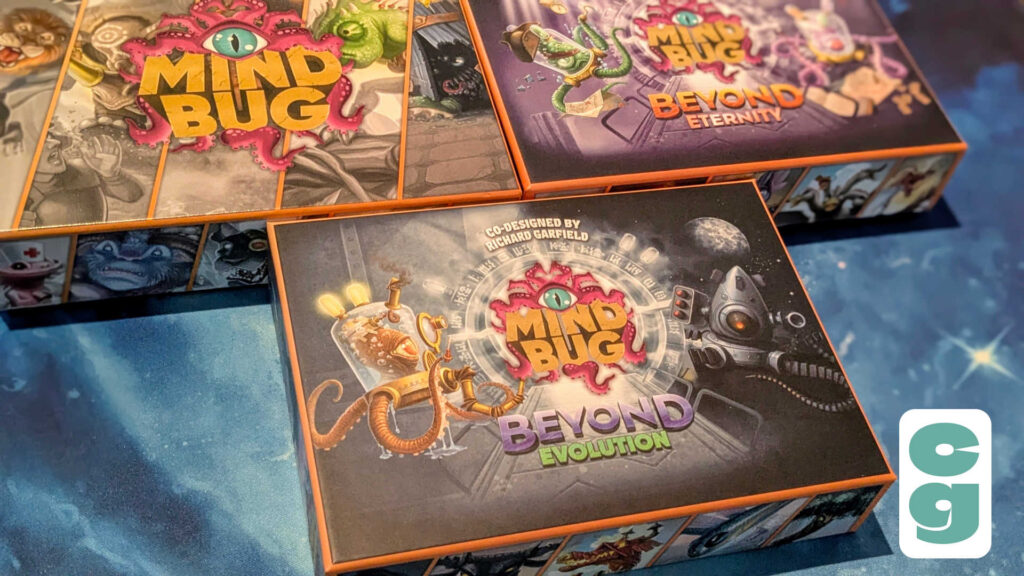
There are currently three versions of Mindbug available: the original Mindbug, Beyond Evolution, and Beyond Eternity (the latter of which will be reviewed soon). To play the game, you’ll just need one of these; of course, as we’re focusing on Mindbug: Beyond Evolution, that’s the one you’ll need to pick up if you want to take advantage of its unique gameplay features.
Mindbug: Beyond Evolution is designed to primarily be a two-player game, but it’s possible to play with four players, using the rules found on the official Mindbug website. Note that these are, at the time of writing, marked as experimental; though they are functional, it’s probably fair to say that it’s not the “best” way to play.
Setup for Beyond Evolution is broadly the same as standard Mindbug, with no prep time, no deck building, and players using cards from the same, main deck. Players each take two Mindbug cards, a life spinner dial (set to 3), then are each dealt 10 cards each from the main deck, with the rest of the cards out of use for the round. Players then deal themselves five cards each from their personal, 10-card deck, and play can begin.
What’s New in Mindbug: Beyond Evolution?
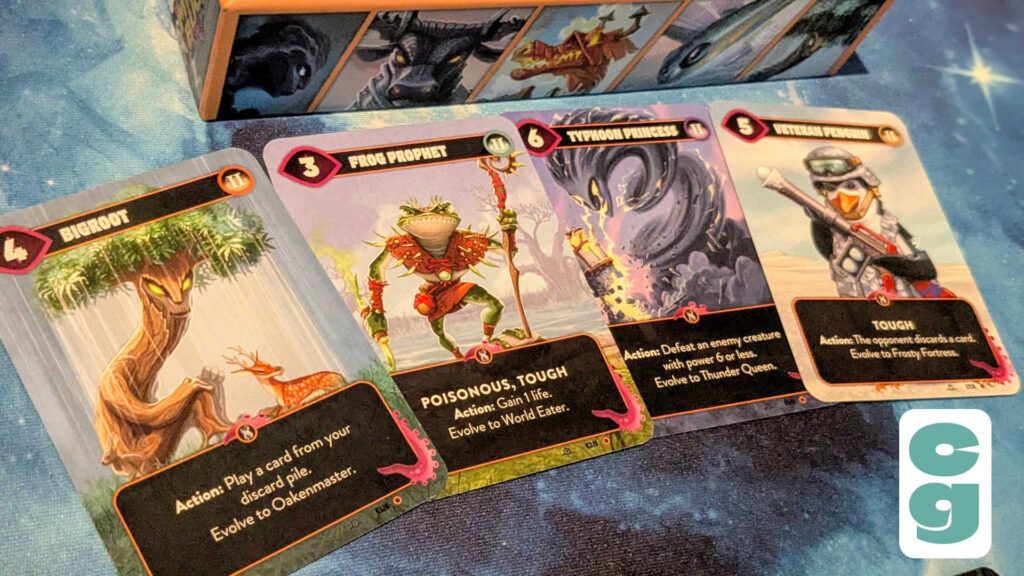
Of course, you’ll note the use of the word broadly above, in terms of the setup of a game of Mindbug: Beyond Evolution, compared to standard Mindbug. That’s because there’s an entirely new type of card in Beyond Evolution; as you can probably guess from this edition’s name, evolved versions of specific creatures are also included, and these will need to be taken out of the main deck and kept separate during play.
In standard Mindbug, taking a turn is simply a choice of either playing a card from your hand or attacking with a creature. In Beyond Evolution, some creatures have the Action trigger effect, which allows them to have a third option: instead of playing a card or attacking, they can instead use the Action on their turn, following the card’s printed effect.
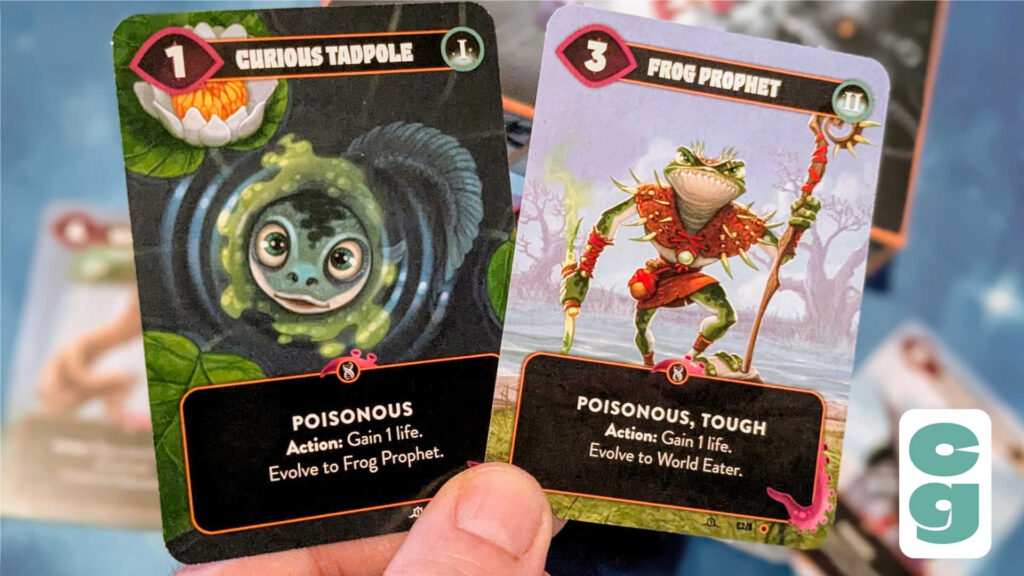
Sometimes this can be evolving, in which case you’ll take the named card and place it on top of the evolving creature, which gives it new stats and abilities.
Each type of creature which can evolve has three forms. Stage 1 is a standard card played from hand, whereas the stage 2 and 3 are on each side of a double-sided card. The stage 2 card is played on top of the stage 1, and when evolving to stage 3, the stage 2 card is simply flipped over.
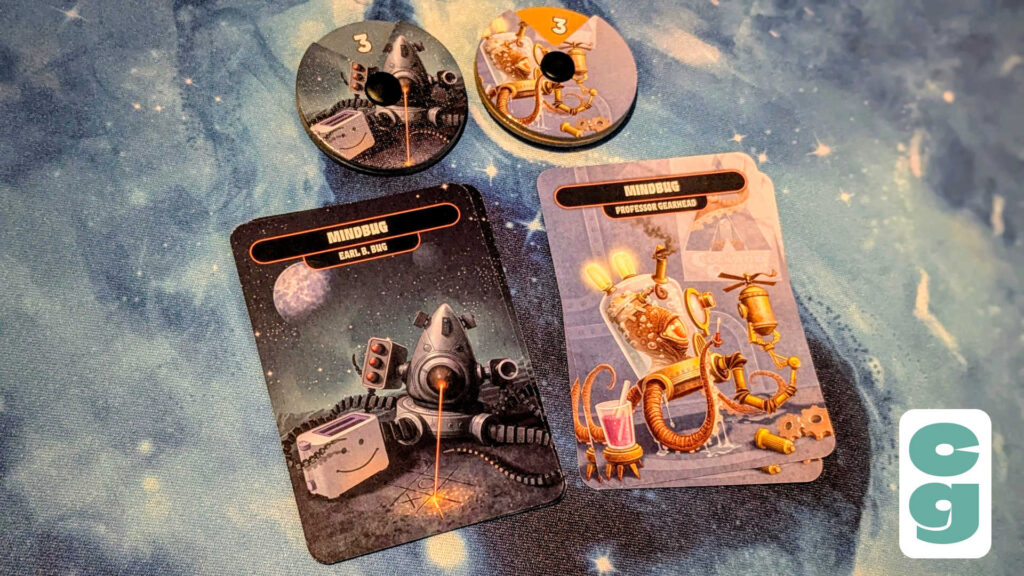
That’s the major gameplay change to Mindbug: Beyond Evolution, though all creatures are also new and unique to this expansion; the Mindbug cards themselves now have quirky names too (Professor Gearhead and Earl B. Bug, in case you were wondering!). All of the keywords from the original Mindbug (Frenzy, Hunter, Poisonous, Sneaky, and Tough) remain the same in Mindbug: Beyond Evolution.
Though Mindbug: Beyond Evolution can be played as a completely separate, standalone game, players can mix in the cards (all, or just those of their choice) from Mindbug, if they choose to.
Is Mindbug: Beyond Evolution Fun to Play?
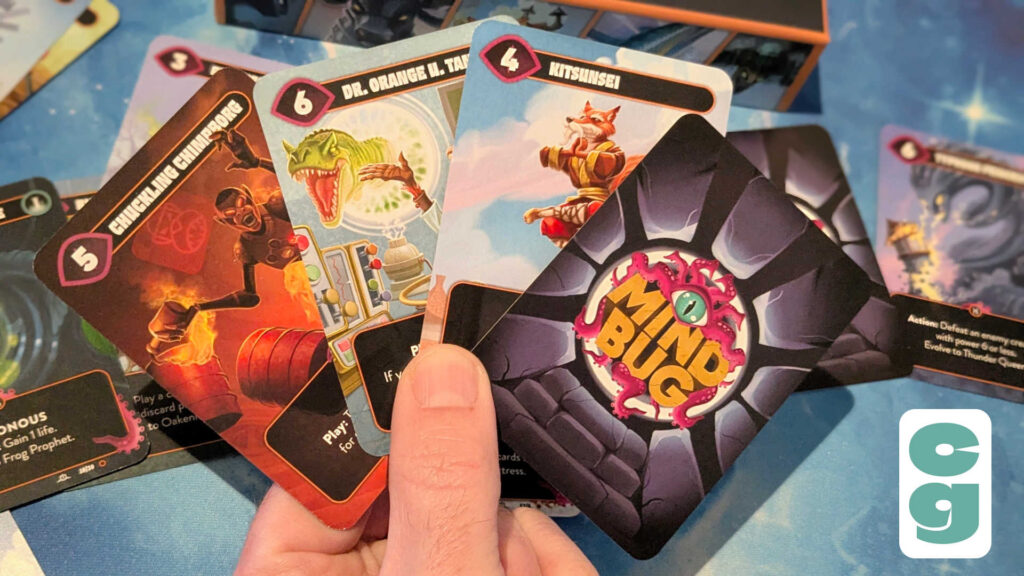
The short answer to that question is a definite yes! Just like the original game, Mindbug: Beyond Evolution is a very simple game to learn and get started with, and its simplicity belies a surprising depth of card interactions and choices on every turn. The strength of Mindbug’s overall design really shines through; the interactions between the five various keywords remain as intricate and clever as in the original game, and the evolving creatures add a new layer to the experience too.
Having those evolving creatures does make Mindbug: Beyond Evolution ever so slightly more complex than Mindbug, and there are numerous creature abilities, which counter or nullify certain keywords or effects, which can make the game a bit less newcomer friendly than the original game. That’s certainly not a bad thing, and given how simple the game of Mindbug is in general, this may not be much of a dealbreaker anyway. If you’re intending to play with much younger players, or very inexperienced opponents, the original Mindbug is the best entry point to the game itself.
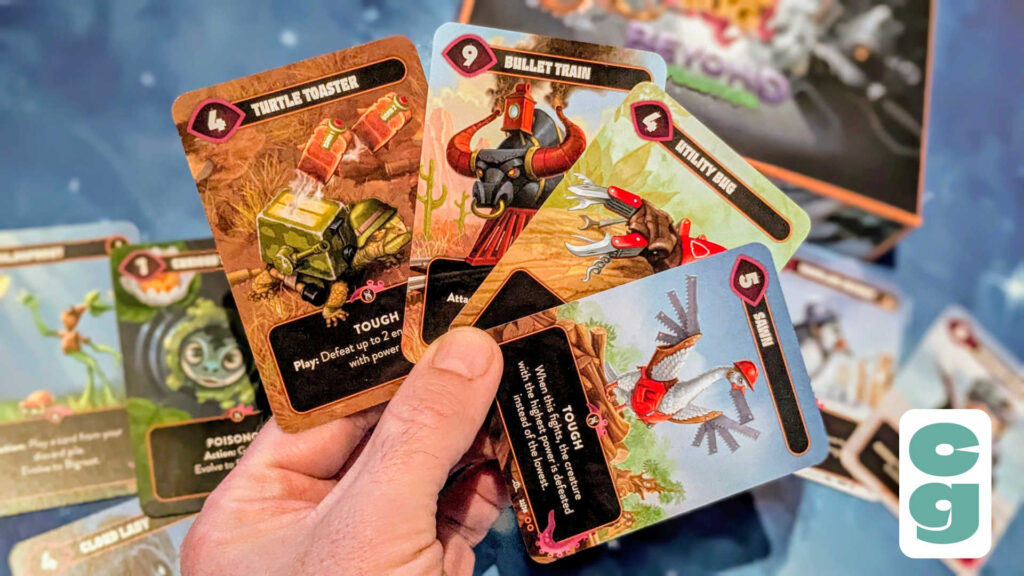
The creature designs (and their entertainingly pun-filled names!) are excellent, once more, with wonderful illustrations, and a bit more of a bio-mechanical feel overall this time.
Like its predecessor, Mindbug: Beyond Evolution has the feel of an involving, aesthetically pleasing and cleverly designed trading card game (or TCG), albeit in a nicely self-contained, small, and reasonably priced box. It’s a great choice of starting point for slightly more experienced card game players, or as an addition to a growing Mindbug collection, if players have already familiarized themselves with the game’s charms via the original release.
The Card Gamer Verdict
The original Mindbug is undoubtedly one of the best two-player card games I’ve ever played, and Mindbug: Beyond Evolution is a great next step. A slightly less accessible and beginner-friendly experience than standard Mindbug, it retains the feel of much larger, more complex (and expensive!) trading card games, in a compact and affordable package. The charm of the game’s aesthetic carries over from the first Mindbug too, with the creature designs appropriately “evolving” to a more bio-mechanical style.
Also like the first game, Mindbug: Beyond Evolution punches way above its weight, being fantastic value for money as a game that has a surprising amount of variability and gameplay possibilities. The ability to add the different versions of Mindbug together gives it even more replayability and variance, though we’d still recommend picking up the original Mindbug instead, if you or your opponents are less experienced with more strategic or slightly more complex card games.
Nevertheless, Mindbug: Beyond Evolution is a fine addition to the Mindbug range, and can stand alongside its predecessor as one of the very best two-player, non-collectible card games available right now.
Want to check out other standalone card games that Card Gamer have reviewed? Take a look at our thoughts on Gloom, or the deckbuilding action of Star Trek: Star Realms!


